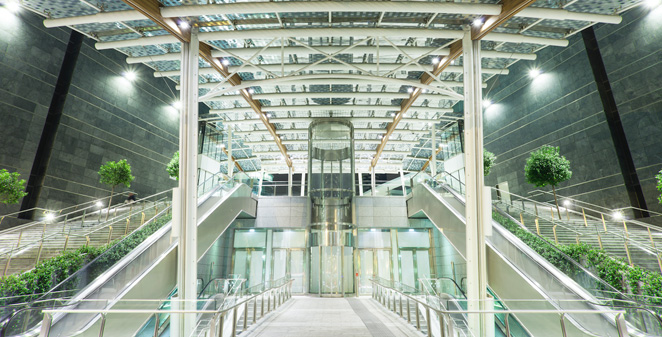In high-rise buildings, elevators are not just an afterthought—they are a critical part of the building’s overall functionality and design. As skyscrapers continue to grow taller and more sophisticated, the challenges of moving people and goods efficiently and safely across multiple floors become increasingly complex. From structural integrity to mechanical engineering, elevators in high-rise buildings require careful consideration in their design, installation, and operation. Here’s a deep dive into the key structural and mechanical considerations that go into creating an elevator system capable of handling the demands of skyscrapers.

High-Speed Elevators for Tall Buildings
One of the primary challenges of elevators in high-rise buildings is the need for speed. With skyscrapers often reaching hundreds of meters, elevators need to travel great distances quickly to minimize wait times and improve user experience. High-speed elevators are designed with advanced motors, cables, and systems that can safely propel the car at speeds of up to 20 feet per second or more.
To achieve such speeds, elevator systems often use gearless traction technology, where the motor drives a pulley system to move the elevator car along the shaft. This system eliminates the need for a gear mechanism, which reduces friction and improves speed and efficiency. These advanced systems can be powered by permanent magnet motors, which are lighter, more efficient, and offer higher speeds compared to traditional systems.
However, high-speed elevators present their own set of challenges. The longer the travel distance, the greater the inertia and centrifugal forces acting on the elevator. To mitigate this, elevators are designed with vibration-dampening systems and buffer mechanisms to ensure a smooth ride, even at higher speeds. Additionally, safety features such as overspeed governors and braking systems are built in to prevent dangerous acceleration or deceleration.
Elevator Shaft Design and Structural Considerations
The structural integrity of a high-rise building’s elevator system is integral to its success. Elevator shafts must be carefully designed to accommodate the large, heavy equipment while ensuring smooth operation over time. In taller buildings, elevator shafts can extend over a vast distance, requiring precise calculations to ensure they remain rigid and do not sway with the movement of the building.
To maintain stability, elevator shafts are typically reinforced with steel or concrete and are often integrated with the building’s overall structural frame. The design of the shaft must also consider the need for clearances, ventilation, and accessibility for maintenance personnel.
As buildings grow taller, the need for machine room-less (MRL) elevators becomes more common. In these systems, the motor and drive components are located at the top of the shaft, rather than in a separate machine room. MRL elevators are more space-efficient and are often used in high-rise buildings to maximize usable floor space.
Double-Decker and Sky Lobby Systems
In very tall buildings, double-decker elevators and sky lobby systems are often implemented to improve efficiency. Double-decker elevators have two stacked cabins, allowing them to serve two floors at once. This configuration is particularly useful in skyscrapers, where there may be a large number of floors with high traffic demand. The system can significantly reduce wait times and optimize the movement of people throughout the building.
In conjunction with double-decker elevators, many high-rise buildings use sky lobbies—intermediate floors where passengers are transferred from local elevators to express elevators. This strategy reduces the total number of elevator stops and increases the efficiency of vertical transportation. Express elevators in tall buildings often serve the upper floors directly, bypassing multiple intermediate floors to provide faster service.
Safety Mechanisms and Redundancy Systems
Safety is paramount when designing elevators for high-rise buildings, as the risks associated with malfunctioning or failure are magnified by the building’s height. To ensure safety, modern elevators in skyscrapers are equipped with an array of advanced redundant systems to prevent accidents and minimize downtime.
For example, overspeed governors automatically slow the elevator down if it exceeds a certain speed. Buffer systems at the bottom of the shaft help absorb shock in the event of a malfunction. Additionally, automatic rescue devices (ARDs) are built into modern elevator systems to ensure that in the event of a power failure, the elevator can still reach the nearest floor and safely open its doors.
High-rise buildings also rely on fire-resistant materials for elevator shafts, ensuring that they remain safe and functional even in the event of a fire. Elevator systems are typically equipped with smoke detectors and sprinklers to comply with safety regulations. Furthermore, elevators must be able to operate even during a building evacuation, allowing people to safely exit the building in case of an emergency.
Energy Efficiency and Sustainability
As skyscrapers continue to grow taller, energy efficiency becomes an even more critical consideration. Modern elevator systems in high-rise buildings are designed with energy conservation in mind. For instance, regenerative drive systems capture the kinetic energy created when the elevator moves down and convert it into usable electricity to power the building. This reduces the overall energy consumption of the elevator system and contributes to the building’s sustainability goals.
Additionally, smart elevator controls use real-time data to optimize elevator performance, reducing unnecessary energy use by grouping passengers efficiently and adjusting the system’s operation based on current demand. For example, if a building is less busy during off-hours, the elevator system can be programmed to operate with less frequency, further reducing energy consumption.
The role of elevators in high-rise buildings goes far beyond simply moving people from one floor to the next. In skyscrapers, elevators must be designed to operate efficiently and safely at great heights, considering factors such as speed, structural integrity, safety, and energy efficiency. Modern elevator systems in tall buildings incorporate innovative technologies, including high-speed motors, regenerative drives, and adaptive traffic management, to improve the building’s performance while ensuring a smooth and safe experience for occupants. As high-rise buildings continue to reach new heights, elevator design will remain a critical component in shaping the future of urban architecture.
